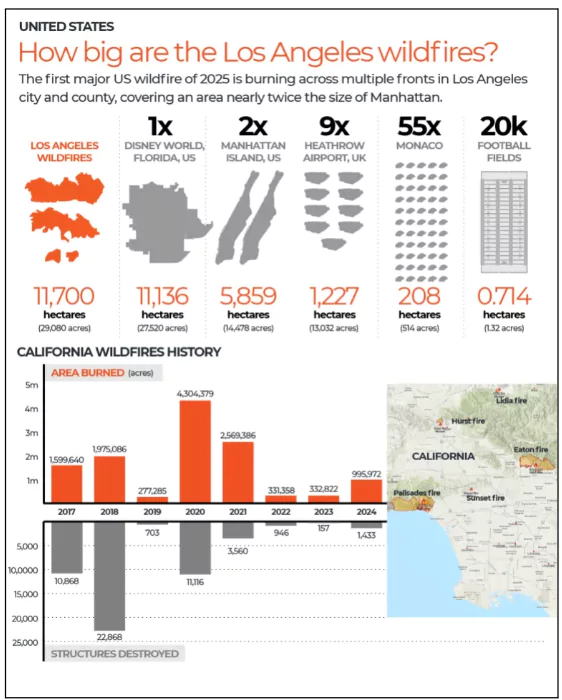Wildfires have ravaged multiple parts of Los Angeles in California affecting nearly 180,000 residents.
- At least five gigantic fires were burning to the north, east, and west of the Los Angeles area.
About the Los Angeles Wildfires
- Area: The fires have consumed about 56 square miles (145 square km), an area larger than San Francisco
 Start: The fire started in Palisades located on the Pacific Ocean affecting at least 19,978 hectares (49,367 acres) and spreading rapidly to other neighbourhoods.
Start: The fire started in Palisades located on the Pacific Ocean affecting at least 19,978 hectares (49,367 acres) and spreading rapidly to other neighbourhoods.
- Other Affected Areas: Eaton, Hurst, Lidia, Kennet
- Cause: The Wildfires are attributed to a number of reasons,
- Drought Conditions: The winters of 2022 and 2023 saw unusual rains followed by the driest start to the winter season in 2024 leading to a build up of dry, combustible vegetation.
- Strong Santa Ana Winds: The prevailing strong Santa Ana winds made the flames get bigger and spread faster across Los Angeles devouring the kindling of dry vegetation, power cables, wooden houses built to withstand earthquakes, etc.
- Santa Ana winds are a natural part of California’s climate pattern, and usually blow from October to January.
- Climate Change: California experienced its hottest ever June and July, and the second hottest October in 2024 with the second driest spell in the region in 150 years.
- The excessive heat and absence of rain had already turned the vegetation very dry when the Santa Ana began to blow.
Enroll now for UPSC Online Course
Phos-Chek: The Pink Fire Retardant
- Fire Retardants are a mix of chemicals used to extinguish or slow down the spread of fires. The US authorities usually use Phos-Chek (fire retardant) containing an ammonium phosphate-based slurry.
- It is typically made up of salts such as ammonium polyphosphate, which does not evaporate easily like water and stays for longer.
- Colour: Pink colour is usually added to the fire retardant to create fire lines around the fire retardant ensuring that firefighters can see it against the landscape.
- Concern: Using Fire Retardants can cause potential harmful effects for the environment, and human health.
- Carcinogenic: Phos-Chek is laden with toxic metals like chromium and cadmium which can cause cancer, and kidney and liver diseases in human
- Environmental Damage: A 2024 study by University of Southern California has found that 850,000 pounds of Phos-Chek is released into the environment since 2009
- For Aquatic Life: These retardants also enter waterways and their toxic metals are harmful and can kill aquatic life.
- Effectiveness: The effectiveness of aerial retardants depends on environmental conditions such as slope, fuel type, terrain and weather.
|
About Wildfires
- A wildfire, forest fire, or a bushfire is an unplanned, uncontrolled and unpredictable fire in an area of combustible vegetation.
- Types: Wildfires can burn in vegetation located both in and above the soil.
- Ground Fires: It typically ignites in soil thick with organic matter feeding the flames, like plant roots. These flames can burn for an entire season until conditions are right for them to grow to a surface or crown fire.
- Surface Fires: They burn in dead or dry vegetation that is lying or growing just above the ground. Parched grass or fallen leaves often fuel surface fires.
- Crown Fires: They burn in the leaves and canopies of trees and shrubs.
- Cause:
- Natural: Natural events like lightning strikes or spontaneous ignition aided by strong and dry wind conditions can cause wildfires
- Human Activities: Wildfires can also be started by human activities, such as debris burning, vehicle fires, cigarette butts, or campfires, breaking of power lines and other electrical equipment etc.
- Pre-Requisite: Wildfires need 3 main factors to fuel,
- Dry fuel such as leaves, grass, branches, and other organic materials
- Oxygen in the air
- Heat to ignite and burn
Check Out UPSC CSE Books From PW Store
About California’s Wildfire Season
- California generally experiences wildfires during June and July, and they can run until October
- As per the, ‘Wildfire Weather: Analyzing the 50-year shift across America Report’ published by the nonprofit Climate Central in May 2023.
- The state now has twice as many fire weather days (when weather conditions are favourable for wildfires) than in the early 1970s
- Intensified:10 of the biggest California wildfires have occurred in the last 20 years with five of them in 2020 alone as per a 2023 study published in PNAS.
|
![]() 13 Jan 2025
13 Jan 2025

 Start: The fire started in Palisades located on the Pacific Ocean affecting at least 19,978 hectares (49,367 acres) and spreading rapidly to other neighbourhoods.
Start: The fire started in Palisades located on the Pacific Ocean affecting at least 19,978 hectares (49,367 acres) and spreading rapidly to other neighbourhoods.
